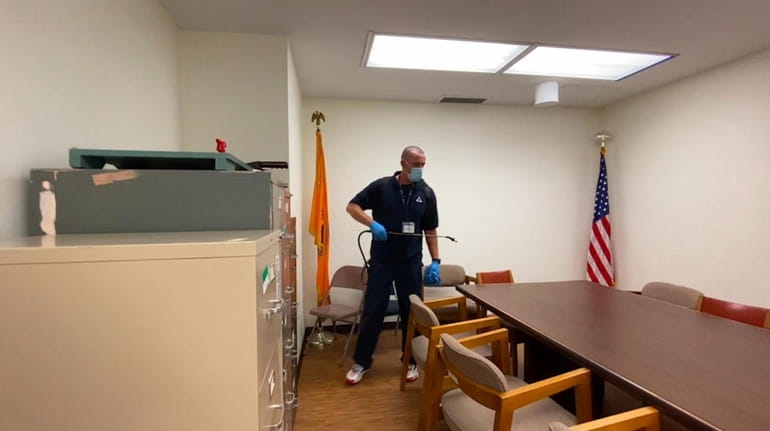Nassau, Suffolk County workers poised for return to offices

As offices across Long Island begin to reopen Wednesday under Phase 2 of the state's reopening plans, Nassau and Suffolk counties are rushing to reconfigure buildings for thousands of government workers, many of whom are leery of returning to sites where they'll have contact with the public for the first time in months, union leaders and county officials said.
Over the past several weeks, particularly in Nassau, county workers have been moving cubicles and desks farther apart, installing Plexiglas partitions and signs reminding people to socially distance and marking elevator floors with X's for where passengers should stand.
Agencies are creating rules on how to interact with the public, making some formerly walk-in services "appointment only," officials said.
The number of workers in government offices will be reduced to comply with state and federal guidelines implemented since the coronavirus pandemic began. Some staffers likely will have to agree to stagger their hours or go into the office on alternating days, working from home the rest of the week.
“It’s not going to be the same as pre-COVID; there are going to be a lot of changes,” said Brian Schneider, deputy Nassau County executive for parks and public works. “You’re not going to be able to just walk in and get a marriage license like you once did.”
While many county workers such as first responders, police and health department staff have reported for duty throughout the pandemic, there are thousands of unionized county workers in Nassau and Suffolk who have been working remotely for weeks.
Nassau County officials plan to reopen a dozen priority buildings, including 240 Old Country Rd., where offices including the county clerk and Department of Assessment are located, and the Theodore Roosevelt Executive & Legislative Building, both in Mineola, as soon as Wednesday.
Suffolk officials did not have a firm timetable for the full reopening of county offices. But they said they were working with department heads to identify employees who will need to be on-site, and those who can continue to work from home.
Under Phase 2, Gov. Andrew M. Cuomo will permit offices for professional services such as law, accounting and government to reopen with 50% of workers and clients at any given time. If an office has a certificate of occupancy for 200 people, for instance, it can reopen for only 100 people, including staff and members of the public.
State guidelines require individuals to keep a distance of at least 6 feet at all times. If at any time workers or visitors must come within 6 feet of each other, they will have to wear protective masks or acceptable face coverings. Individuals also must be prepared to don face coverings if someone unexpectedly comes within 6 feet.
Meetings will be limited and office workers will use tele- or videoconferencing whenever possible. Essential in-person meetings should be held in open, well-ventilated spaces with appropriate social distancing among participants, and shared workstations must be cleaned and disinfected between users.
In Nassau, all surfaces in county buildings will get a daily deep cleaning, officials said. Once a week, crews will use portable machines to rain a disinfectant mist that can kill 99.9% of viruses and bacteria down onto desks, paperwork and floors.
Dan Levler, president of Suffolk Association of Municipal Employees, which represents about 6,000 active Suffolk County workers, said the question he and others grapple with is: “How can we continue to provide government services efficiently while protecting our members and the public?"
Levler, a member of Suffolk's task force on reopening, said 40% to 45% of AME office employees will continue to work remotely.
Levler said he and others charged with the reopening of county offices have had “conversations that are very good with lots of comprehensive guidance.”
He continued, “I wouldn’t say there haven’t been hiccups across the way. Let's just say there have been some supervisors who have interpreted the guidelines creatively.”
Levler and other union representatives say among their chief concerns is whether workers will adhere to social distancing guidance, and who will monitor employees to make sure they are following the new rules.
But Levler and officials in County Executive Steve Bellone's office said with about 2.5 million square feet of county office space, physical distancing won't be difficult to achieve as many desks already are 6 feet apart.
Levler also said for many county employees, child care is "absolutely a concern" as schools, most summer camps and day care centers remain shuttered.
"Childcare remains at the heart of the conversation when we request reasonable accommodations that a member can remain productive while still caring for their families,” Levler said.
Ron Gurrieri, president of Nassau County CSEA Local 830, which represents 4,800 active employees, said returning to work is going to be like "facing the unknown of your first day on the job.”
He predicted, “people are going to go to work with a lot of trepidation. It’s like going to a new job all over again because of the fear that people contracted this [coronavirus] at work and we don’t know where it came from.”
However, Gurrieri and Levler noted new county policies protecting employees who contract COVID-19 from health care costs. Under the policies, it is assumed the worker contracted the disease on their county job, making the county responsible for proving the employee did not contract the virus while in the office.
Nonetheless, Nerca Balcioglu, an office assistant in the Suffolk Department of Social Services, said she was concerned about returning to the office.
The mother of two from Ronkonkoma said she was concerned about contracting the virus or infecting her family, noting her husband is chronically ill with muscular dystrophy. She also expressed concern about leaving her children, particularly her 8-year-old daughter who is on the autism spectrum.
“When they go to school I can go to work and I can manage but now it’s a special situation and I don’t have anyone at home to take care of them,” Balcioglu, 38, said. “It’s like you have to choose between your family or choose your job.”
Balcioglu credits union representatives for helping strike a compromise with her supervisors. She will continue to work from home as a contact tracer, using her Spanish language skills to help find contacts of people with confirmed COVID-19 cases.
“I’m very grateful and I will do my best so this can work out for everybody,” Balcioglu said.
REOPENING GOVERNMENT OFFICES
Long Island is on track for reopening offices for professional services such as law, accounting and government work. Following are some mandatory guidelines that will be in force:
- Limit the number of occupants to no more than 50% capacity per the certificate of occupancy.
- Maintain a distance of at least 6 feet between office employees at all times.
- Prohibit the use of elevators by more than one person unless face coverings are used.
- Meetings should be held in well-ventilated spaces with enough space for participants to sit 6 feet apart.
Source: New York State, office-based guidelines for reopening of New York

